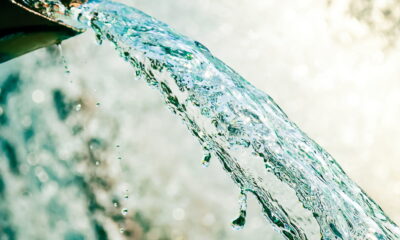

Environment
Eco-Friendly Advocates Explore Innovative Way To Maximize Water Supply
Most environmental discussions center around climate change. However, there are other environmental issues that warrant discussion. One of them is the dwindling water supply.
There are currently 2.7 billion people without adequate access to water. This figure is likely to get worse as pollution, population growth and climate change escalate.
There are more people living on earth today than in any other time in history. In the last two hundred years alone, the world’s population has increased from approximately 1 billion to 7 billion. It’s an amazing fact when you consider that, at the start of human history millions of years ago until 10,000 BCE, only an estimated one million individuals inhabited the earth at any one time. Over the following 10,000 years, growth continued at just .04% annually. However, as we entered the 19th century and beyond, our numbers exploded over seven times! Today, the world’s population is “6.5% of the total number of people ever born[!]”
The effects of this population surge mean we need to be ever more mindful of how we provide the food we need while still safeguarding our resources for future generations. Our track record hasn’t been great. Today, three in 10 people don’t have access to clean water; farming practices and climate change have combined to limit clean water supplies with little promise for improving conditions without a concentrated push for better water conservation and sustainability initiatives. Here are a few ways we all can help conserve and preserve water resources:
Reduce Our Use
Of course, the number one way we can all do our part is limit our water usage. According to the EPA, the average American uses 88 gallons of water each day. Since we know we’re not drinking 88 gallons every 24 hours, we have to be wasting a good deal of it. Sure, we need to bathe and wash things with water, but we can turn off faucets between tasks, fix any leaks in a timely manner, run full washloads and install water-efficient appliances in order to reduce our water consumption.
Determine Our Water Footprint
Awareness is critical for change. We need to be conscious of the amount of water it takes to make the things we buy. Each of us has a water footprint that reveals the true extent of our water usage, which extends far beyond the amount utilized for our household needs. For instance, it takes water to feed the cows from which we get beef to eat — 47 eight-minute showers worth to produce a 7 ounce steak to be exact, according to The Water Footprint Network. In fact, livestock and crop production is one of the biggest contributors to water waste and water pollution. With both come severe implications for the worldwide water supply as most of the products we buy consist of ingredients and materials that come from multiple places around the globe with varying water sources and production outcomes. As individuals, we need to be cognizant of the amount of water it takes to produce everything we buy and use, from the clothes we wear and the food we eat to the activities we enjoy (like visiting an amusement park or going to the theater) so that we can make consumer choices that safeguard water preservation and conservation. And if we sell commodities, we can research clean and safe water practices. Farmers, for example, can use market research resources (such as Ag Access) to learn from other agriculture producers about trending water issues and best (or worst) water preservation and conservation practices so that they can implement their own beneficial water processes.
Practice Sustainability
Dedication to a sustainable lifestyle as a whole necessarily promotes healthier water usage, as well. Think about it: the simple act putting leftovers in a compost bin rather than down the drain (which requires water to run the disposal) or in the trash (where it goes to a landfill and can possibly contribute to water pollution) helps preserve and protect the water supply. In addition, reusing and recycling old clothes and linens can help curb further water resource depletion by limiting the manufacture of new consumer products. Even just buying fewer things helps, as less consumer demand means less stuff is being made and less water is being used!
Protecting Our Water Supply Should Be a Vital Concern
Water scarcity is a looming threat for humanity. It will only get worse. This is a serious environmental issue that we should all focus on.


 Environment9 months ago
Environment9 months agoAre Polymer Banknotes: an Eco-Friendly Trend or a Groundswell?

 Environment11 months ago
Environment11 months agoEco-Friendly Home Improvements: Top 7 Upgrades for 2025

 Features8 months ago
Features8 months agoEco-Friendly Cryptocurrencies: Sustainable Investment Choices

 Features10 months ago
Features10 months agoEco-Friendly Crypto Traders Must Find the Right Exchange





























